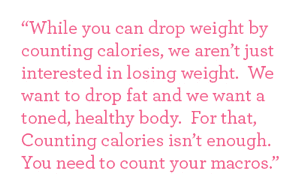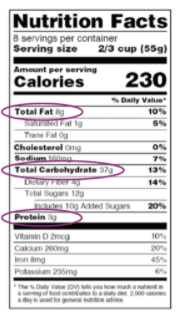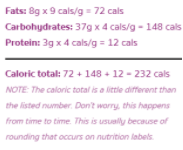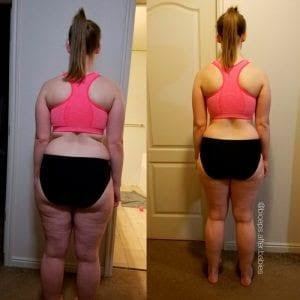MACROS 101 is now CLOSED! Be first in line for the next round HERE!
What are Macros?
Years ago if you had asked me what “macros” were I would have stared at you with a blank face. Now, it’s the most powerful tool that I and thousands of my clients use to look good in our jeans while also eating the food we love.
What Is Macros Counting, And
Why Does It Work?
In the last several years “macros” have become quite the buzz word and it may feel like everyone is talking about counting them right now.
The reason is simple – it works.
By setting and tracking your macros you get the right nutrition in the right ratios to support your performance, physique, and health goals. It provides structure yet with enough latitude to build a menu that works for YOU.
Select from the Topics Below to Learn More
If you are like most of the women I work with one of your goals may be to lose weight. Every few years there seems to be a new diet trend that everyone jumps to try out. “You want to lose weight? Just eat low-fat!” “Or maybe high-fat, low carb?” “No, really you should just eat like a caveman.” “Or at least eat like a caveman for 30 days.” “But really, if you just cut out sugar, and don’t eat after 7pm, you will lose weight!”
The novelty of these diet trends makes them tantalizing, but let me tell you a surprisingly simple secret based in science – the way to lose weight is to be in a calorie deficit over time. That means, you need to consume fewer calories than you use. That’s it! That is the secret. You can lose weight eating low-fat, or Paleo, or Whole30, or no-sugar, or even nothing but Twinkies and Oreos. If you eat fewer calories than your body burns on any of those diets you will lose weight. Crazy, right? It’s true.
For all you skeptics, Mark Haub, professor of human nutrition at Kansas State University, decided to test this theory. For 10 weeks all he ate was processed Twinkies, Doritos, Oreos, and sugar cereals. The catch? He only ate those foods, but limited them so that he was still in a caloric deficit. The result? He lost 27 pounds. It is all about science – calories in versus calories out. If all you want to do is lose weight, calculate the number of calories you burn every day, eat 20% less calories and voila, you will lose weight regardless of the quality of food you are putting into your body.
Just to be clear, that’s not the same as proclaiming food quality doesn’t matter. We all know that broccoli provides our body more micronutrients than a cookie, however, in terms of weight loss or gain calories reign supreme.
If losing weight is all about calories in versus calories out why bother with tracking your macros? Because, while being in a caloric deficit will result in weight loss, the quality of weight loss is very different depending on what type of calories you eat.
With the risk of sounding too “science-y” macro is an abbreviation of the word “macronutrient” which is any of the nutritional parts of food that are required in relatively large amounts for good health: protein, carbohydrate, fat, and minerals such as calcium, zinc, iron, magnesium, and phosphorous. When you hear about someone “counting their macros,” though, it usually refers to tracking the amount of carbs, protein, and fat they consume – because those are the macronutrients that provide calories.
When we say “counting your macros,” we’re talking about tracking your calories, but specifically breaking those calories down into your intake of carbs, fat, and protein.
This approach to eating is also known as “flexible dieting” or “If It Fits Your Macros” or just simply “Macro Counting.” Macro Counting, is a tool that revolves around you eating a set number grams of daily carb, protein, and fat each day. It is essentially a form of guided calorie counting.
You’ve already learned that losing weight really comes down to eating fewer calories than you expend, and any method of cutting calories will result in weight loss; however, the quality and permanence of that weight loss can vastly differ.
Knowing how much of each macronutrient to include in your diet—rather than just counting general calories—will yield better results.
Most people say that they want to “lose weight,” but what they REALLY mean is they want to lose fat. Very few people actually have in their minds that they want to lose muscle or organ tissue or water weight. Those factors also make up weight on the scale, but that’s not what people want to get rid of. They want to decrease the amount of fat on their bodies while also maintaining as much lean muscle as possible. To do that, you need to have a balanced macronutrient intake.
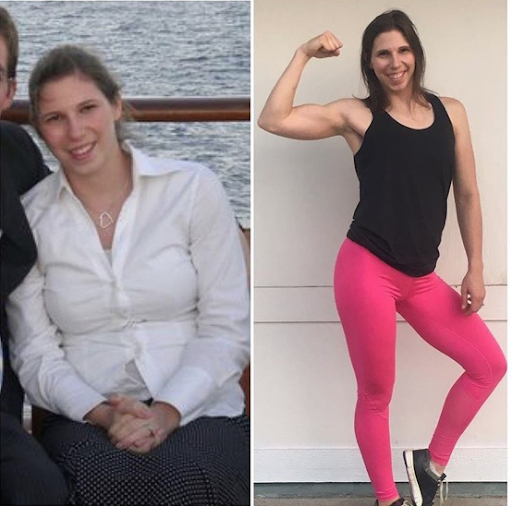
If your macro intake isn’t balanced, the quality of your weight loss suffers. For example, if you aren’t eating enough protein during a calorie deficit, your body will break down muscles to use for energy. If you aren’t getting enough carbohydrates you can feel weak and unable to perform well during workouts, because carbs are fuel! Lastly, not getting enough fat into your diet can mess with your hormones and make your weight loss stall or make it more difficult for you to put on muscle, because fats increase your growth hormones. While you can drop weight by counting calories, we aren’t just interested in losing weight. We want to drop fat and we want a toned, healthy body. For that, counting calories isn’t enough. You need to count your macros.
One problem with many diets is that they encourage you to eat fewer calories by cutting out entire food groups. “Don’t eat gluten! Don’t eat sugar! Low carb is best! Only eat clean foods!” All of these diets will tell you that certain foods are off-limits. Some people are able to cut out dairy or grains or sugar 100% and never crave another donut for as long as they live. However, many more people – myself included – shudder at the thought of never being able to eat another bowl of ice cream, or slice of pizza, or fresh baked donut again.
In contrast, with Macro Counting nothing is off-limits. There aren’t “good” and “bad” foods, it’s all just food. Food is made up of certain macronutrients and you have a daily goal of how many of each macronutrient to hit. So if you want ice cream for dessert you can have it! You just have to make sure that you don’t go over your daily allotment of carbs or fat. If you fit it into your macros then it’s not a cheat, it’s not bad – it fits! If it fits your macros you can eat it without any guilt or feeling like you “cheated” on your diet. This is a sustainable way of eating.
Now, don’t get me wrong, it’s really hard to eat processed junk food all day long and still hit your macros. Most of the food you consume is going to need to be traditionally healthy food like lean protein, fruits, and vegetables. 80% of the food I eat on a daily basis is nutrient dense “healthy” food. But the beauty of Macro Counting is that you can easily make room for the treats that you want AND still hit your weight loss goal. It’s a moderate, healthy way to approach eating.
You may be asking yourself, “Does tracking macros take up a lot of time and energy?” The short answer is yes and no. I won’t lie. Because getting an accurate read on your macro intake requires weighing and logging everything you eat, the first couple of weeks can feel time intensive. However, after the first 2 weeks or so, it gets much easier and faster. I can log my whole day of eating within a matter of 5 minutes now. So, no, it is not difficult to do once you get the hang of it. And for me, once I started seeing the results, the counting and tracking was 100% worth it.
Most foods you eat have a nutrition label that looks like this:
On the nutrition label, you will always see the three macronutrients listed with the number of grams the product contains.
In this nutrition label, you can see the following:
- 8g of fat
- 37g of carbs
- 3g of protein
Based on the caloric value for a gram of each of the macro nutrients listed above (1 gram carb = 4 calories, 1 gram protein = 4 calories, 1 gram fat = 9 calories), you can see how this product’s 230 calories are broken into the three macros:
If what you are eating doesn’t have a nutrition label (think: an apple), then you can use a database (like MyFitnessPal) to calculate the macronutrients.
I’ve had the pleasure of coaching over 4,000 women and seeing each woman be able to use the tool of macro counting to create a customized plan that works for her and her unique body. Check out some of our client’s success stories.
After having my twins I really struggled to lose the baby weight. Amber gave me a plan to reduce my body fat and build muscle through counting macros. Even after completing my coaching, I am still able to use the knowledge she gave me to continue my health journey.
– Addison
Cutting calories in any form is going to help you lose weight. But if you tell me that you aren’t going to eat any carbs or sugar ever again (or any other extreme restriction used to lose weight), then I’d say you have more willpower than 99% of the population. Chances are you will “mess up” by eating something off-plan and then feel guilty.
With counting macros (you will also hear it called IIFYM – If It Fits Your Macros – or flexible dieting), there aren’t “good” and “bad” foods; it’s all just food. Flexible dieting is built on the basic knowledge of certain macronutrients and gives you a precise amount of each macronutrient to include in your diet.
If you want ice cream for dessert, have it! You just have to make sure not to go over your daily allotment of carbs or fat. If you fit it into your macros, it’s not a cheat, it’s not bad—it fits! And if it fits your macros, you can eat it guilt-free and without feeling like you “cheated” on your diet. This is a sustainable way of eating.
Don’t get me wrong; it would be really hard to eat processed foods and treats all day long but still hit your macros. Most of the food you consume needs to be nutrient-dense food like lean meats, whole grains, fruits, and vegetables. But the beauty of flexible dieting is that you can easily make room for treats and still reach your weight-loss goal. It’s a moderate, healthy way to approach food.
If I have convinced you that macro counting is a sensible and effective way to lose weight your next question should be,
First, I highly suggest downloading my free Counting Macros Starter Kit. This will walk you through the basics and create a solid foundation from which to start your macro counting journey.
Second, purchase a food scale so you can weigh your food in grams. Weighing your food isn’t required, however it is highly recommended. Yes, you can scoop out ½ cup of oatmeal but sometimes that ½ scoop will be 35g and sometimes it may be 60g and that makes a big difference when you are tracking your macros. Weighing your food may seem like a pain at first, but I promise it becomes a habit and it really doesn’t take that much extra time.
Third, start logging what you eat normally. There are many apps to use for this, but the one that I know and love is MyFitnessPal. It’s free and you can use it on any phone or computer and it’s pretty intuitive to use. Try not to change the way you are eating and log your foods for 1 week. You aren’t trying to hit any macros or calories – just learning how to weigh and log foods and getting an idea of how many calories and what ratio of macros you are currently eating.
Last, calculate your customized macros. I have several resources to help you calculate your starting macros:
Option 1: Download my free guide to help you customize your macros to your body and goals. I also highly recommend you listen to episode 11 of Biceps After Babies Radio: Macros Aren’t Magic – How To Set Your Macros, episode 132 Top 5 Mistakes Made When Setting Your Own Macros, and episode 133: I Set My Macros…What’s Next.
Option 2: Invest in my online program Confidence In Your Numbers where you’ll be guided through learning how to set your starting macros and also how to adjust them over time (because your starting macros will not be your finishing macros).
Option 3: Have a Team BAB coach set your starting macros for you. You’ll submit your tracked normal intake and a comprehensive questionnaire which will allow our trained coaches to customize your macros to your body, your lifestyle, and your goals.
Last, if you aren’t on the waitlist for my signature coaching program yet click here to add yourself. MACROS 101 opens several times a year and allows you to get personalized coaching through your fitness journey.
The bottom line for me is living a lifestyle that is maintainable for the long haul. Macro Counting isn’t a crash diet. You don’t have to commit to never having another fresh baked cookie ever again. You can find moderation in eating AND lose fat at the same time. And for me, THAT’S the beauty of macro counting.
Get to Know Our Signature Program
MACROS 101
Lose the weight you want WITHOUT cutting out the food you love… In only 20 minutes a day. Learn how to ditch the “dieter” guilt and shame. Discover how to look and feel amazing in your body. And, get life-changing results from the plan you’ll create that’s 100% customized to YOU.





